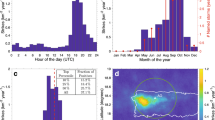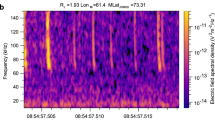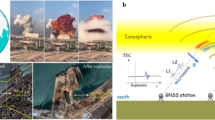Abstract
A connection between thunderstorms and the ionosphere has been hypothesized since the mid-1920s1. Several mechanisms have been proposed to explain this connection2,3,4,5,6,7, and evidence from modelling8 as well as various types of measurements9,10,11,12,13,14 demonstrate that lightning can interact with the lower ionosphere. It has been proposed, on the basis of a few observed events15, that the ionospheric ‘sporadic E’ layer—transient, localized patches of relatively high electron density in the mid-ionosphere E layer, which significantly affect radio-wave propagation—can be modulated by thunderstorms, but a more formal statistical analysis is still needed. Here we identify a statistically significant intensification and descent in altitude of the mid-latitude sporadic E layer directly above thunderstorms. Because no ionospheric response to low-pressure systems without lightning is detected, we conclude that this localized intensification of the sporadic E layer can be attributed to lightning. We suggest that the co-location of lightning and ionospheric enhancement can be explained by either vertically propagating gravity waves that transfer energy from the site of lightning into the ionosphere, or vertical electrical discharge, or by a combination of these two mechanisms.
This is a preview of subscription content, access via your institution
Access options
Subscribe to this journal
Receive 51 print issues and online access
$199.00 per year
only $3.90 per issue
Buy this article
- Purchase on Springer Link
- Instant access to full article PDF
Prices may be subject to local taxes which are calculated during checkout



Similar content being viewed by others
References
Wilson, C. T. R. The electric field of a thundercloud and some of its effects. Proc. Phys. Soc. Lond. 37, 32–37 (1925)
Bauer, S. J. A possible troposphere-ionosphere relationship. J. Geophys. Res. 62, 425–430 (1957)
Bhar, J. N. & Syam, P. Effect of thunderstorms and magnetic storms on the ionisation of the Kennelley-Heaviside Layer. Phil. Mag. J. Sci. 23, 513–528 (1937)
Mitra, S. K. & Kundu, M. R. Thunderstorms and sporadic E ionisation of the ionosphere. Nature 174, 798–799 (1954)
Rastogi, R. G. Thunderstorms and sporadic E layer ionisation. Indian J. Meteorol. Geophys. 1, 43–54 (1957)
Ross, W. B. & Henderson, J. T. Radio studies of the ionosphere. Nature 133, 523–524 (1933)
Velinov, P. I., Spassov, Chr. W. & Kolev, S. I. Ionospheric effects of lightning during the increasing part of solar cycle 22. J. Atmos. Terr. Phys. 54(10), 1347–1353 (1992)
Taranenko, Y. N., Inan, U. S. & Bell, T. F. Interaction with the lower ionosphere of electromagnetic pulses from lightning: heating, attachment and ionisation. Geophys. Res. Lett. 20, 1539–1542 (1993)
Pasko, V. P., Stanley, M. A., Mathews, J. D., Inan, U. S. & Wood, T. G. Electrical discharge from a thundercloud top to the lower ionosphere. Nature 416, 152–154 (2002)
Sentman, D. D. et al. Simultaneous observations of mesospheric gravity waves and sprites generated by a midwestern thunderstorm. J. Atmos. Terr. Phys. 65, 537–550 (2003)
Inan, U. S., Rodriguez, J. V. & Idone, V. P. VLF signatures of lightning-induced heating and ionisation of the night-time D-region. Geophys. Res. Lett. 20, 2355–2358 (1993)
Inan, U. S., Slingeland, A. & Pasko, V. P. VLF and LF signatures of mesospheric/lower ionospheric response to lightning discharges. J. Geophys. Res. 101, 5219–5238 (1996)
Kelley, M. C. et al. Electrical measurements in the atmosphere and the ionosphere over an active thunderstorm. 1. Campaign overview and initial ionospheric results. J. Geophys. Res. 90, 9815–9823 (1985)
Kelley, M. C., Ding, J. G. & Holzworth, R. H. Intense ionospheric electric and magnetic field pulses generated by lightning. Geophys. Res. Lett. 17, 2221–2224 (1990)
Watson-Watt, R. A. Discussion on the ionosphere. Proc. R. Soc. 141, 715–718 (1933)
Lee, A. C. L. Ground truth confirmation and theoretical limits of an experimental VLF arrival time difference lightning flash location system. Q. J. R. Meteorol. Soc. 115, 1147–1166 (1989)
Bibl, K. & Reinisch, B. W. The universal digital ionosonde. Radio Sci. 13, 519–530 (1978)
Whitehead, J. D. Recent work on mid-latitude and equatorial sporadic-E. J. Atmos. Terr. Phys. 51, 401–424 (1989)
Plane, J. M. C., Self, D. E., Vondrak, T. & Woodcock, K. R. I. Laboratory studies and modelling of mesospheric iron chemistry. Adv. Space Res. 32, 699–708 (2003)
Davis, C. J., Wild, M. N., Lockwood, M. & Tulunay, Y. K. Ionospheric and geomagnetic responses to changes in IMF Bz: a superposed epoch study. Ann. Geophys. 15, 217–230 (1997)
Samson, J. C. & Yeung, K. L. Some generalizations on the method of superposed epoch analysis. Planet. Space Sci. 34, 1133–1142 (1986)
Shatkhin, Kh. J. Ionospheric-tropospheric relationships. Geomag. Aeronomy 4, 623–625 (1964)
Shrestha, K. L. Sporadic-E and atmospheric pressure waves. J. Atmos. Terr. Phys. 33, 205–211 (1971)
Liu, J. Y. et al. Vertical phase and group velocities of internal gravity waves derived from ionograms during the solar eclipse of 24 October 1995. J. Atmos. Solar-Terr. Phys. 60, 1679–1686 (1998)
Larsen, M. F. Wind shears in the mesosphere and lower thermosphere: Results from four decades of chemical release wind measurements. J. Geophys. Res. 107(A8), 1–14 (2002)
Chimonas, G. Enhancement of sporadic E by horizontal transport within the layer. J. Geophys. Res. 76, 4578–4586 (1971)
Sato, K. Vertical wind disturbances in the afternoon of mid-summer revealed by the MU-radar. Geophys. Res. Lett. 19, 1943–1946 (1992)
Woodman, R. F. & Kudeki, E. A causal relationship between lightning and explosive spread F. Geophys. Res. Lett. 11, 1165–1167 (1984)
Armstrong, W. C. Lightning triggered from the Earth's magnetosphere as the source of synchronised whistlers. Nature 327, 405–408 (1987)
Schunk, R. W. & Nagy, A. F. Ionospheres: Physics, Plasma Physics, and Chemistry 243 (Cambridge Univ. Press, Cambridge, 2000)
Acknowledgements
The authors wish to thank S. Hockenhull for prompting this investigation, J. Smith for maintaining the Chilton ionosonde, P. Odams of the UK Meteorological Office for supplying the Arrival Time Difference data, A. Ruddell for supplying the pressure data and E. Williams for his support and encouragement. The ionosonde at Chilton is funded by the UK Particle Physics and Astronomy Research Council, as is the UK Solar System Data Centre at the Rutherford Appleton Laboratory, where ionospheric data from Chilton and other stations are made available.
Author information
Authors and Affiliations
Corresponding author
Ethics declarations
Competing interests
Reprints and permissions information is available at npg.nature.com/reprintsandpermissions. The authors declare no competing financial interests.
Rights and permissions
About this article
Cite this article
Davis, C., Johnson, C. Lightning-induced intensification of the ionospheric sporadic E layer. Nature 435, 799–801 (2005). https://doi.org/10.1038/nature03638
Received:
Accepted:
Issue Date:
DOI: https://doi.org/10.1038/nature03638
This article is cited by
-
Survey of electron density changes in the daytime ionosphere over the Arecibo Observatory due to lightning and solar flares
Scientific Reports (2021)
-
Using GNSS radio occultation data to derive critical frequencies of the ionospheric sporadic E layer in real time
GPS Solutions (2021)
-
Significant Day-time Ionospheric Perturbation by Thunderstorms along the West African and Congo Sector of Equatorial Region
Scientific Reports (2020)
-
The intensification of metallic layered phenomena above thunderstorms through the modulation of atmospheric tides
Scientific Reports (2019)
-
Thunderstorm-related variations in the sporadic E layer around Rome
Acta Geodaetica et Geophysica (2015)
Comments
By submitting a comment you agree to abide by our Terms and Community Guidelines. If you find something abusive or that does not comply with our terms or guidelines please flag it as inappropriate.



